The Silent Addiction to Everyday Painkillers16 September 2013 | Admin Market Harborough Chiropractor concerns about back pain and increased painkiller addiction
Written By davecasey6719@gmail.com, On September 16, 2013 The silent addiction to everyday painkillers Forget cannabis and heroin. Thousands of utterly respectable Britons are in the grip of an insidious and deadly drug addiction – to everyday painkillers, such as Nurofen. In pharmaceutical circles the ‘silent addiction’. Which is more insidious, harder to pinpoint and easy to ignore. Like thousands of other unregistered and unrecorded addicts up and down the country, Mel Smith was abusing over-the-counter painkillers. The comedian Mel Smith had admitted he had an addiction to Nurofen Plus. In doing so he was putting himself at risk of – among other things – liver failure, serious stomach damage, gall bladder problems, Irritable Bowel Syndrome and respiratory problems – yet ironically he had no idea he was an addict. Mel sadly died recently. Mel was just one of an increasing number of people becoming slowly addicted to everyday painkillers, here’s Marks story- ‘For a few months I took the basic paracetamol but that hardly touched the pain. Then three months later I remember pleading with a chemist for some pain relief. He gave me a box of Panadol Ultra. I took it home, tried two, and not only did the pain subside but I felt relaxed.’ From then on, I was never without his box of Panadol Ultra or Nurofen Plus. ‘I took Panadol Ultra and Nurofen Plus every day for 13 years, and for most of that time I had no idea that I was doing myself any harm, let alone displaying the classic signs of addiction,’ says Mark, from Derbyshire. Opiates have long been used as painkillers, and codeine is an effective pain receptor inhibitor, enhancing the action of standard painkillers such as ibrobrufen. Like all opiates, codeine induces a feeling of calm and well-being – but if taken in big enough doses, for some people it can be addictive, with significant side effects if they try to stop. In addition, says neurologist Michael Gross, who runs clinics for people addicted to over-the-counter medication, the painkillers themselves can be the cause of headaches and back pains. ‘You get a migraine or back pain and initially the painkiller works. But for some reason the effect starts to lessen over time. So why do the painkillers stop working. ‘We know that the brain learns to have headaches and possibly neck and shoulder and back pain. Once the pain pathways are opened up the headaches become more common, this is often seen with back pain because the pain returns again and again. This process is exacerbated by any painkiller, not just codeine. So the thing you take to get rid of pain makes you more sensitive to pain. You have to question why take painkillers then, should we look at better ways to manage back pain instead of relying on painkillers only. Physical treatments such as chiropractic can overtime untrain the brain and reduce need for painkillers or reduce the dosage. ‘Some experts believe this can happen if you only take around six painkillers a week, but certainly if you are taking the full recommended dose every day you may get this effect. ‘It’s called medication overuse syndrome, it is medically recognised and it is happening to around 100,000 people in this country. According to Dr Gross, even the basic painkillers can have this effect, but because the codeine-based products are stronger, the effect of addiction is much quicker. ‘With the codeine products you have the extra problem of the opiate addiction,’ he explains. Both ibrobrufen and paracetamol, if taken beyond the recommended safe dose, can cause serious and life -threatening illnesses, exceeding the dose several times over is dicing with death. Paracetamol can seriously damage your liver, and ibruprofen can cause the stomach lining to be destroyed. People regularly overdose and die from their addiction and many end up having parts of their stomach chopped out where the ibruprofen has caused massive damage. Although no official statistics exist to document the extent of the problem, addiction to the codeine in OCT painkillers has long been recognised within the medical and pharmaceutical industry. In 2005, the Medicines and Healthcare products Regulatory Agency (MHRA) and the Proprietary Association of Great Britain, the UK trade and standards association for the manufactures of OTC drugs, investigated the problem. Simon Greasley is a clinical nurse specialist in drug dependency who has extensive knowledge of codeine addiction. He helps run the Codeine-Free website and believes one of the reasons codeine dependency goes unreported is because it is hard for misusers to see themselves as addicts. Everyday respectable people who have no idea they can be addicted to something legally on sale in this country. ‘Most of them start off by taking painkillers to treat an existing real pain, but then, once the original pain is gone, the need for the pills is still there. It’s not surprising when you consider each plus-strength tablet contains around 12mg of codeine.’ The guidelines for the Royal Pharmaceutical Society of Great Britain state that pharmacists and their staff must be aware of the abuse potential of certain OTC products, and should not supply them if there are reasonable grounds for suspecting misuse. If you would like to manage back pain and headaches without drugs call The Chiropractic Clinic in Market Harborough or The Melton Mowbray Chiropractic Clinic and see if chiropractic care helps you. | 
